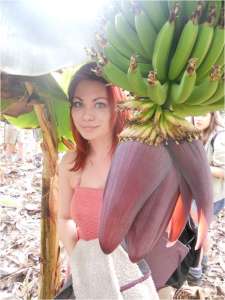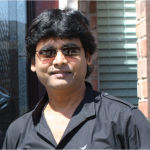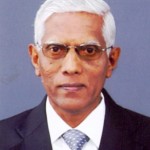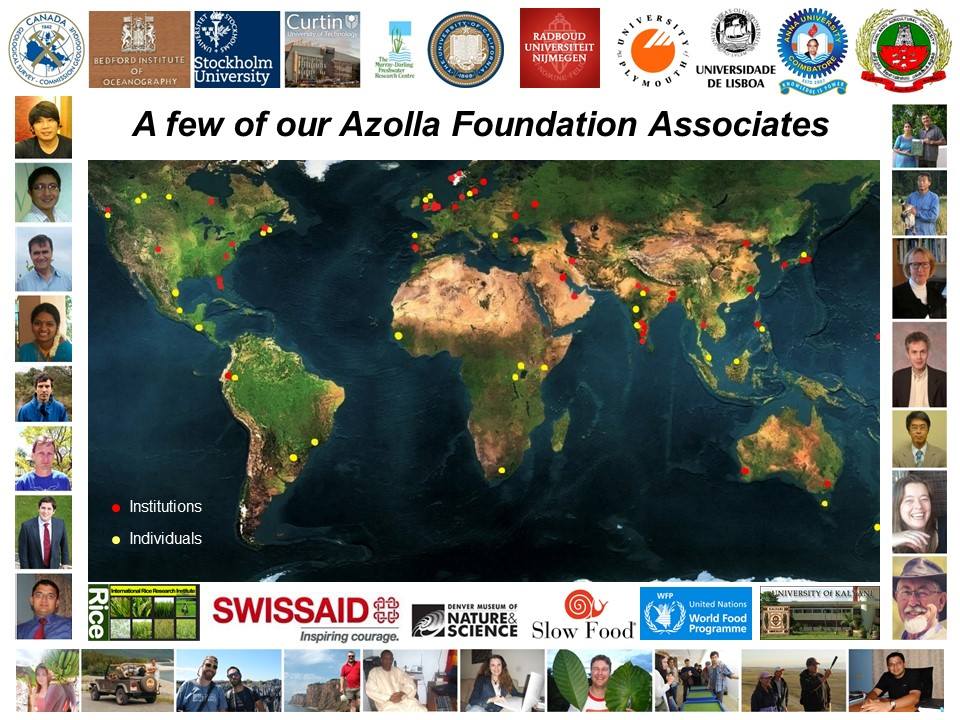 Map showing some of our Foundation Associates and their affiliated institutions.
Map showing some of our Foundation Associates and their affiliated institutions.
The Azolla Foundation works on projects involving azolla with the following Associates around the world. Please contact us for email addresses that are not listed.
Alexandra Bujak, Environmental Scientist and co-founder of the Azolla Foundation and Azolla BioSystems Ltd
Alexandra is dedicated to preserving endangered species and ecosystems.
Her Environmental Degree dissertation at the UK’s Manchester University quantified azolla’s potential to sequester the greenhouse gas carbon dioxide, as illustrated on this page of the Azolla Foundation website.
Alexandra set up and runs the Azolla Foundation’s Facebook and its pages for different countries and areas including the Philippines. Azolla Foundation Facebook has more than 15,000 members, and their posts provide a wealth of information about their use of azolla.
Dr Jonathan Bujak, geologist, paleontologist and co-founder of the Azolla Foundation and Azolla BioSystems Ltd with his daughter Alexandra Bujak
During the 1970s and 1980s, Jonathan was a Research Scientist at the Geological Survey of Canada’s east coast facility located on the campus of the Bedford Institute of Oceanography in Darmouth, Nova Scotia. It was during this period that he first observed 50 million year old Arctic sediments containing abundant fossils of azolla that record the Arctic Azolla Event.
Jonathan was a participating scientist on both the 1979 Lomonosov Ridge Experiment (LOREX) and the 2004 Arctic Coring Expedition (ACEX), the only two expeditions to successfully core sediments beneath the North Pole.
Jonathan’s work is now focused on ways in which modern azolla can help us weather the Perfect Storm – the related shortages of land, freshwater, food and energy, and the threat of imminent climate change as our population passes seven billion.
AUSTRALIA
Dr Kliti Grice, Professor and Founding Director of WA-Organic and Isotope Geochemistry Centre, Perth
 Professor Kliti Grice is an internationally renowned organic geochemist who creatively combines geological information with data on molecular fossils and their stable carbon and hydrogen isotopic compositions to reconstruct details of microbial, fungal and floral inhabitants of ancient aquatic environments.
Professor Kliti Grice is an internationally renowned organic geochemist who creatively combines geological information with data on molecular fossils and their stable carbon and hydrogen isotopic compositions to reconstruct details of microbial, fungal and floral inhabitants of ancient aquatic environments.
Dr Grice is especially well known for identifying a geological and environmental basis for the largest mass extinction in Earth’s history, which happened at the end of the Permian Period, about 252 million years ago.
Kliti is working with the Azolla Foundation to determine azolla’s potential as a renewable and sustainable biofuel source, and ways in which azolla can be used to enhance the biofuel potential of algae and, in particular Botryococcus braunii.
Alan Marshall, independent azolla researcher, Tasmania
 Alan Marshall is a retired medical radiographer. Following two years of volunteering in East Africa in the 1970s, he became interested in alternative technology and ecology and now lives in Tasmania.
Alan Marshall is a retired medical radiographer. Following two years of volunteering in East Africa in the 1970s, he became interested in alternative technology and ecology and now lives in Tasmania.
Finding some Azolla filiculoides in the pond of a neighbour, Alan did some research on the Internet and took an instant fascination with this unique fern. Needing to find a safe, simple and ecological way of treating grey water (bathroom, laundry and kitchen), he experimented with sequential filtration and found that azolla is very effective in removing phosphorus and other contaminants from the grey water. The resulting biomass is a useful additive to compost, thereby returning extracted nutrients to the soil and providing an example of azolla’s use for natural recycling and sustainability.
Alan can be contacted at anakial193@gmail.com and his innovative work can be view here:
http://theazollafoundation.org/azollas-uses/waste-water-treatment/
http://jonnycomelately.hubpages.com/hub/Azolla-filiculoides-in-Tasmania
http://jonnycomelately.hubpages.com/hub/Mulch-Filter-for-Grey-Water-Clean-up
Alan spent several months in India, the Philippines and the UK during 2014 and 2015 to work on azolla projects that included teaching local farmers about its use and application for local, low-cost, sustainable farming.
Dr Gavin Rees, Assistant Director and Senior Scientist at the Murray-Darling Freshwater Research Centre, Victoria, Australia
 Dr Rees is a microbiologist specializing in [1] the ecology of aquatic bacteria and fungi and their role in carbon and nutrient cycles, and [2] microbial community structures. His interest in azolla is related to water quality and microbial activity.
Dr Rees is a microbiologist specializing in [1] the ecology of aquatic bacteria and fungi and their role in carbon and nutrient cycles, and [2] microbial community structures. His interest in azolla is related to water quality and microbial activity.
You can view his 2012 lecture on the extensive growth of azolla in Broken Creek, Victoria, Australia here.
BOLIVIA
François Laviolette, technical adviser and promoter of azolla’s multiple uses
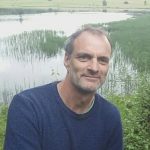 François Laviolette first became interested in azolla in 1985 thanks to Professor Charles Van Hove in Belgium.
François Laviolette first became interested in azolla in 1985 thanks to Professor Charles Van Hove in Belgium.
He has confirmed that Professor Van Hove’s azolla collection no longer exists in Belgium, but that equivalent specimens were donated to the IRRI’s Azolla germplasm collection.
François has been working with azolla for more than 20 years in southern Bolivia where he is involved with projects to use Azolla filiculoides as a fodder, fertilizer, sequester of the greenhouse gas carbon dioxide, mulch for water conservation in reforestation program and as a high-quality compost called ‘bocashi‘. It also prevents fish predation by some birds as they are discouraged from diving into ponds that are partly covered with azolla.
François says that “for the last two years, more and more Bolivian farmers and technical advisers are taking an interest in azolla, not only as a fodder and organic fertilizer, but also as a key factor for erosion mitigation. It is incredible in stopping erosion by helping to ‘naturally’ fill up erosional holes by creating organic-rich clay soils which do not erode and in which seeds or plants can develop.” (personal communication to Jonathan Bujak)
In addition, François is promoting azolla’s use to clean sewage water and reduce water loss through evaporation. He is also using azolla to promote the development of new ecological niches that encourage other plant and animal species to thrive in semi-desert areas near to southern Bolivia’s town Tarija.
He is also involved in azolla projects in Africa.
François is based in both Belgium and Bolivia and he can be contacted at francoispatty@hotmail.com
CANADA
Andrew Bujak, chef and promoter of sustainable agriculture, Calgary
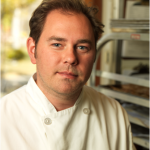 Andrew Bujak is a leading Canadian chef and member of the International ‘Slow Food Movement’, which promotes the enjoyment and protection of locally-produced food products and regional cooking.
Andrew Bujak is a leading Canadian chef and member of the International ‘Slow Food Movement’, which promotes the enjoyment and protection of locally-produced food products and regional cooking.
Andy’s culinary path has led him to create a range of menus and recipes based on ingredients that are sustainable and sourced as locally as possible, resulting in his passion for natural agricultural methods. He recognizes the multiple benefits that azolla can provide to farmers and to regenerate damaged soils back to health.
Andy is experimenting with various techniques to grow and cook azolla including fusion cooking and azolla’s use as a nutraceutical (‘super food’). He is actively promoting azolla’s use as a biofertilizer, livestock feed and food to his colleagues at the Slow Food movement.
He can be contacted at andyalecbujak75@gmail.com
Frank Moreau, owner of Moreau’s Aquatics in Simcoe County, Ontario
 Frank Moreau is a member of the International Lemna Association and the St. Catharines and Area Aquarium Society. He has been an aquarist for several years, specializing in the propagation of aquatic plants including Azolla caroliniana, Lemna minor, Lemna trisulca and Pistia stratiotes (water lettuce). Frank is making a series of videos on azolla and these are the weblinks to his first two showing the beauty of azolla:
Frank Moreau is a member of the International Lemna Association and the St. Catharines and Area Aquarium Society. He has been an aquarist for several years, specializing in the propagation of aquatic plants including Azolla caroliniana, Lemna minor, Lemna trisulca and Pistia stratiotes (water lettuce). Frank is making a series of videos on azolla and these are the weblinks to his first two showing the beauty of azolla:
https://www.youtube.com/watch?v=QBA_IJJ9tb4
https://www.youtube.com/watch?v=yHq91slaxec
https://www.youtube.com/watch?v=aEfSZj5Zjd0
Frank can be contacted at frankamoreau@gmail.com
Geological Survey of Canada
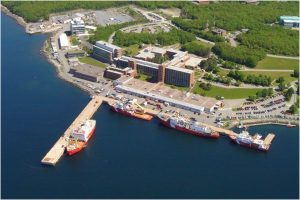
The GSC’s Atlantic facility is located on the campus of the Bedford Institute of Oceanography with its fleet of ocean-going research vessels.
The Geological Survey of Canada (GSC) is responsible for performing geological surveys of the country, developing Canada’s natural resources and protecting the environment.
Founded in 1842, it is the country’s oldest scientific agency and includes world-renowned geologists who have contributed to our understanding of global geology including paleobotany.
The GSC has also contributed greatly to our understanding of the geological, oceanographic and climatic history of the Arctic, including the 50 million year old Arctic Azolla Event.
Dr Robert Fensome and Dr Graham Williams, Geological Survey of Canada

Left: Rob Fensome doing field work at Cape d’Or, Nova Scotia; Right: Graham Williams discussing the geology of Cape d’Or.
Rob Fensome and Graham Williams are palynologists and Senior Research Scientists at the Geological Survey of Canada’s Atlantic facility which is located on the campus of the Bedford Institute of Oceanography in Darmouth, Nova Scotia.
Their research on climatic and oceanographic reconstructions of the North Atlantic region includes sediments of the same age as the Arctic Azolla Event, providing a direct comparison with conditions in the Arctic Ocean.
They are the authors of numerous scientific papers including many that were co-authored by Azolla Foundation Associate, Dr Jonathan Bujak, who was also a Research Scientist at the GSC during the 1970s and 1980s.
Graham and Rob are now extending their research into the Arctic including sections containing the Azolla Event.
DEMOCRATIC REPUBLIC OF CONGO
David Cammaerts, biologist
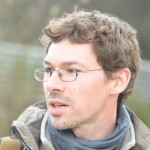 David is a biologist who specializes in water resources and integrated watershed management, also working as an adviser to empower his partners’ projects and ideas. He has been working on the relationship between natural resources and human development for 15 years, with a strong emphasis on cooperation to development. David is particularly passionate about collaborating with local and international partners to build innovative strategies and solutions to solve complex environmental and developmental issues relating to environmental resources management and biodiversity conservation. These include the numerous ways in which azolla could help to solve some of the problems that humanity is facing all around the globe.
David is a biologist who specializes in water resources and integrated watershed management, also working as an adviser to empower his partners’ projects and ideas. He has been working on the relationship between natural resources and human development for 15 years, with a strong emphasis on cooperation to development. David is particularly passionate about collaborating with local and international partners to build innovative strategies and solutions to solve complex environmental and developmental issues relating to environmental resources management and biodiversity conservation. These include the numerous ways in which azolla could help to solve some of the problems that humanity is facing all around the globe.
David is presently setting up a new azolla project in the Democratic Republic of Congo, with the aim of developing local expertise about azolla and to empowering its use as a green manure, a livestock feed, and a tool for soils restoration.
David has written this about his experiences with azolla:
“I first discovered azolla in 2005 during a professional stay in Bolivia. I was already convinced of its potential and my time there gave me the opportunity to successfully use azolla on a small scale for mitigating erosion.
In 2008 I rediscovered azolla in Democratic Republic of Congo when I was working for the Belgian Technical Cooperation Agency in Kindu, Maniema. At that time, we were building a large water network to supply the population of the town of Kindu. We collected water from springs situated in a vast humid area. Because of the construction works, the ground was very muddy and cleared of vegetation, so that the soil was unable to filter rain water. It was therefore necessary to regenerate organic soil and help the vegetation grow as fast as possible. I convinced the local coordinator of the project to explore new ways of soil fertilisation and to let me try to use azolla as a green manure for the develop vegetation in the catchment area. We were able to do this and, thanks to azolla, we succeeded in regenerating new soils that are rich in nitrogen and which have good organic-rich texture. Grasses rapidly colonized the new soils and the resulting vegetation and soil were excellent in filtering the runoff water.”
David is presently based in Belgium and he can be contacted at: davidcammaerts@gmail.com
ECUADOR
The SCIAPLI Corporation: Dr. Mariano Montaño
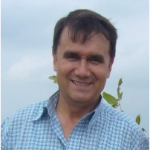 Dr. Mariano Montaño is the Director of the SCIAPLI Corporation in Ecuador. He a tireless campaigner for the use of natural azolla-based biofertilizers as opposed to harmful urea-based chemical fertilizers.
Dr. Mariano Montaño is the Director of the SCIAPLI Corporation in Ecuador. He a tireless campaigner for the use of natural azolla-based biofertilizers as opposed to harmful urea-based chemical fertilizers.
Dr. Montaño is undertaking a major operation in Ecuador’s Guayas Ecosystem where he is using azolla as a biofertilizer in rice cultivation. According to Dr. Montaño: “The incorporation of azolla into rice cultivation in the Guayas Ecosystem will play a strategic role in Ecuador as it will also provide fertilizer for agriculture, food for livestock, water treatment for the Daule, Babahoyo and Guayas Rivers, aquaculture industry improvement in the Guayas Estuary, fisheries stimulation in the Gulf of Guayaquil, soil enrichment, biota recovery, and carbon credits.”
His goal is to extend azolla-anabaena to more sites, so that eventually it is used in all national rice cultivation, which covers some 400,000 hectares and affects over 140,000 families.
EL SALVADOR
Maurico Cornejo Lanza, independent cattle farmer (Granjas Lecheras Tecnificadas) using azolla as livestock feed.
GERMANY / ECUADOR
Bärbel Treiber de Espinosa, Dipl. Biol. (PUCE), Senior Teacher (Biology/Chemistry)
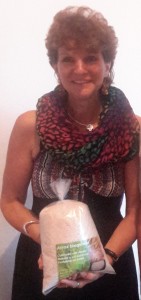 Thirty years ago, when nitrogen fixation by microorganisms was unknown in Ecuador, Bärbel Treiber began her research in the Ecuadorian Andes into the diazotrophic filamentous cyanobacterium Nostoc punctiforme, which is a symbiont of Gunnera plants.
Thirty years ago, when nitrogen fixation by microorganisms was unknown in Ecuador, Bärbel Treiber began her research in the Ecuadorian Andes into the diazotrophic filamentous cyanobacterium Nostoc punctiforme, which is a symbiont of Gunnera plants.
This pioneering work investigated the morphology of the Nostoc-Gunnera symbiosis using transmission electron microscopy, and confirmed its microbiological nitrogen-fixing activity using gas chromatography in the laboratory.
Bärbel then became a member of the Ecuadorian Investigation Team of the Antarctic, where she documented and conducted research into cyanobacterial symbionts in lichens.
On her return to Ecuador, Bärbel met Mariano Montaño, an Azolla Foundation Associate. Mariano believed that nitrogen-fixing microorganisms could be a powerful and natural way to help provide nutrition in Ecuador, beginning a collaborative investigation between Bärbel and Mariano into the azolla-anabaena symbiosis. This included fieldwork to investigate azolla’s distribution in the Guayas Ecosystem, where azolla plants were collected, identified and cultivated, leading to scientific documentation of the influence of azolla on the growth of rice plants.
Their latest collaboration began in summer 2015 into the relationship between synthetic and natural ways in which azolla fixes nitrogen and the resulting quality of proteins.
The photograph shows Bärbel holding a sample of biogenic rice provided by Mariano Montaño Armijos. Bärbel is presently living in Germany.
GUINEA-BISSAU, WEST AFRICA
Tcherno (Cherno) Djaló, Head of the Swissaid Foundation program in Guinea-Bissau
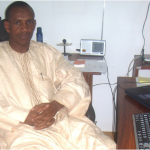 Swissaid has an overall strategic plan, plus local plans for each country in which it operates in accordance with the needs, sociopolitical and economic context of the country. Swissaid Guinea-Bissau priorities are: 1) food sovereignty, 2) extractive industries (transparency in the exploitation of mineral resources), 3) civil society (citizenship), gender and development, and 4) country specific areas.
Swissaid has an overall strategic plan, plus local plans for each country in which it operates in accordance with the needs, sociopolitical and economic context of the country. Swissaid Guinea-Bissau priorities are: 1) food sovereignty, 2) extractive industries (transparency in the exploitation of mineral resources), 3) civil society (citizenship), gender and development, and 4) country specific areas.
As head of local Swissaid Foundation program, Cherno Djaló monitors and evaluates projects supported or funded by the Swissaid Foundation. He also contributes directly to the development of the Foundation program in three ways:
- In the field of food sovereignty, in which Swissaid philosophy is based on ecological and sustainable agriculture (farming without the use of chemicals):
- To strengthen the technical capacities, organizational and financial smallholders (family farming) in order to improve the production and productivity, but also of their economic conditions.
- To give advice to support partner organizations (local development) in the preparation and presentation of adequate project proposals, and following their implementation and final evaluation.
This includes research into azolla’s use in Guinea-Bissau, which was first developed in collaboration with international and subregional research institutions such as the Association for the Development of Rice Culture in West Africa (ex-ADRAO), Faculty of Sciences of the University of Lisbon (FCUL, Portugal), Senegalese Institute of Agricultural Research (ISRA), and the Catholic University of Louvain (Belgium).
Current studies on azolla involve:
- Field work to identify locations where azolla grows and its traditional use by the local population.
- Identifying opportunities for azolla’s use as a biofertilizer in the Bafatá region (eastern Guinea-Bissau) due to its occurrence in the Geba River for 10 months of the year. These include improvement in soil fertility for rice production and increased productivity.
Results from field work have also demonstrated azolla’s use by the local population in the Bafatá region as medicinal plant for kidney disease and as a biofertilizer in cereal, namely rice production.
INDIA
Dr. Pradeep Kagane, Livestock Development Officer for the Government of Maharashtra in Nashik
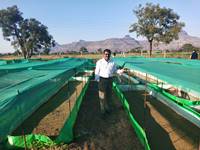 Dr. Pradeep Kagane is an experienced veterinary professional with a degree in Veterinary Medicine and over 30 years’ experience in the livestock industry. He is the Livestock Development Officer for the Government of Maharashtra in Nashik, India, and is enthusiastic about regenerative farming and climate change mitigation.
Dr. Pradeep Kagane is an experienced veterinary professional with a degree in Veterinary Medicine and over 30 years’ experience in the livestock industry. He is the Livestock Development Officer for the Government of Maharashtra in Nashik, India, and is enthusiastic about regenerative farming and climate change mitigation.
Dr. Kagane has developed innovative solutions that use Azolla and Super Napier grass to reduce the greenhouse gas carbon dioxide (CO2) emissions, resulting in extensive socioeconomic benefits. He is widely respected throughout the world and is designated as one of the top 100 innopreneur in south Asia for developing carbon capture solutions. He was a Global Finalist in Climatelaunchpad 2019 that was organised by Climate KIC Netherlands.
Dr. Kagane can be contacted by email at drpradeep.kagane@gmail.com and by phone at +919822662820.
Dr. Arunachalam Lakshmanan, Professor, Tamil Nadu Agricultural University, Coimbatore
Dr. A Lakshmanan (‘Lax’) is an Agricultural Microbiologist working at Tamil Nadu Agricultural University, Coimbatore, India with 19 years of Research and Teaching experience. He has expertise in developing adaptation and mitigation technologies in agriculture for climate change to reduce the vulnerability of climate risks.
Dr. Lakshmanan has been involved in azolla research since 2000 and promoting azolla as biofertilizer in rice through ClimaAdapt Project funded by The Royal Norwegian Embassy, New Delhi. Prof. Lakshmanan has documented the role of an azolla–blue green algal system for minimizing methane emission besides their role in carbon sequestration in rice soils, in this technical brief.
Recently Lakshmanan and his team have been involved in promoting azolla as a feed supplement, which is being funded by the Navajbai Ratan Tata Trust in Mumbai, India. Lakshmanan has standardized the quantity of azolla as wet and dry feed for poultry and livestock, and evaluated the positive impact of azolla for feeding milk animals, broiler and layer birds.
Dr. Lakshmanan and his team have trained more than 4000 beneficiaries including farmers, tribal communities and women’s self-help group volunteers on the easy multiplication of azolla in their backyards and he developed a business model for linking the azolla growers with end-users to create sustainable income for the rural poor.
Dr. Lakshmanan can be contacted at microlaxman@yahoo.com
Dr. Bhavisha Wala, Scientist at Shriram Institute for Industrial Research, Bangalore
 Dr. Bhavisha Wala is working as a scientist at the not-for-profit Shriram Institute for Industrial Research. She has pursued her PhD in ‘transformation of rice’ from the University of Nottingham, UK. Since then Bhavisha has been fascinated by ways in which azolla can help to provide nitrogen fertilizer to paddy fields. Her research field includes angiosperm taxonomy, tissue culture and transformation of plants.
Dr. Bhavisha Wala is working as a scientist at the not-for-profit Shriram Institute for Industrial Research. She has pursued her PhD in ‘transformation of rice’ from the University of Nottingham, UK. Since then Bhavisha has been fascinated by ways in which azolla can help to provide nitrogen fertilizer to paddy fields. Her research field includes angiosperm taxonomy, tissue culture and transformation of plants.
Bhavisha is particularly interested in increasing the nutritional content of azolla and promoting its use as a food for people. She is now investigating the presence of important vitamins in azolla which can help to combat nutritional deficiencies, especially for the vegetarian population.
Gayathri Kothandaraman, Assistant Professor in the Faculty of Biotechnology at India’s Vel Tech High Tech, Affiliated to Anna University
 Professor Gayathri specializes in biopharmaceutical technology and the phytochemical analysis of medicinal plants. Her research fields include the development of drug delivery systems and nanomedicines.
Professor Gayathri specializes in biopharmaceutical technology and the phytochemical analysis of medicinal plants. Her research fields include the development of drug delivery systems and nanomedicines.
Gayathri is working with the Azolla Foundation to determine azolla’s potential for pharmaceuticals, nanomedicine and biofuel production.
Dr. Anand Titus and Geeta N. Pereira, independent coffee growers and researchers into sustainable agriculture
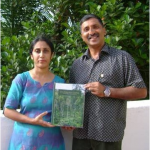 Dr. Anand Titus Pereira has Ph.D. in Microbiology. His wife, Geeta Nanaiah Pereira has a M.S. degree in Horticulture from the Oklahoma State University, U.S.A. This Husband and Wife team own a model coffee farm on the foothills of the Western Ghats in India, a UNESCO World Heritage Site and one of the eight “hottest hotspots” of biological diversity in the world with over 5000 species of flowering plants, 139 mammal species, 508 bird species and 179 amphibian species.
Dr. Anand Titus Pereira has Ph.D. in Microbiology. His wife, Geeta Nanaiah Pereira has a M.S. degree in Horticulture from the Oklahoma State University, U.S.A. This Husband and Wife team own a model coffee farm on the foothills of the Western Ghats in India, a UNESCO World Heritage Site and one of the eight “hottest hotspots” of biological diversity in the world with over 5000 species of flowering plants, 139 mammal species, 508 bird species and 179 amphibian species.
Anand and Geeta’s goal is to protect this rare habitat and they have worked diligently on sustainable technologies for the past 15 years to develop various practical recommendations which are of great benefit to coffee farmers worldwide. These include the use of azolla as a biofertilizer for growing coffee.
You can read about Anand and Geeta’s remarkable work on their website and in their beautifully illustrated 600 page book “ECOFRIENDLY COFFEE ” which covers the flora and fauna of the Western Ghats in relation to coffee plantations.
Natural Resources Development Project (VK-NARDEP)
Dr Kamalasanan Pillai, Natural Resources Development Project (VK-NARDEP)
Dr Pillai is a world expert on azolla and pioneer in azolla’s use as a livestock feed and developed the award-winning technology to produce long shelf-life livestock feed pellets from azolla. Dr Pillai can be contacted at azollapillai@gmail.com.
One example of Dr Pillai’s work is in Kozhikodupothai, a village of 150 households, where weekly meetings and action plans have led to the use of backyard Azolla cultivation by almost all of the farmers: www.vknardep.org/newsletter/vknardep_March_2010.pdf
Azolla BioSystems Ltd and the Azolla Foundation are working with Dr Pillai and VK-NARDEP to present courses on azolla and to develop its use as a livestock feed that provides a sustainable high-protein and low-cost supplement to traditional feeds.
Hinren Technologies Private Limited
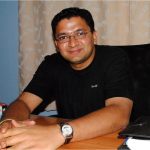 Hinren Technologies provides consultancy and turnkey solutions for Rainwater Harvesting in large apartments, households, industries, communities and farmlands.
Hinren Technologies provides consultancy and turnkey solutions for Rainwater Harvesting in large apartments, households, industries, communities and farmlands.
Azolla BioSystems Ltd and the Azolla Foundation are working with Hinren Technologies to develop azolla as a renewable biofuel and sequester of the greenhouse gas carbon dioxide.
Sunil Mysore, Founder, Director and CEO of Hinren Technologies Private Limited, is a Civil Engineer with experience in entrepreneurship, high-rise construction and water resource management. His passion for sustainable development and environmental engineering fired him to start the company.
Sunil takes a keen interest in sustainable development, renewable energy and developmental economics, including the use of azolla to attain these goals. He can be contacted at sonumysore@gmail.com
Dr Quazi Taheruzzaman, Associate Professor and Head of the Department of Botany, S C College, Burdwan University, Hooghly, West Bengal
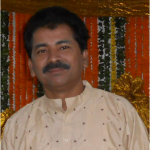 Dr Taheruzzaman did his PhD and Post Doctoral research work at Burdwan University. His research interest is in Aquatic Ecology and he has been actively engaged in azolla research, water pollution and allelopathy since 1984.
Dr Taheruzzaman did his PhD and Post Doctoral research work at Burdwan University. His research interest is in Aquatic Ecology and he has been actively engaged in azolla research, water pollution and allelopathy since 1984.
Quazi’s research with azolla includes:
- Quantification of azolla’s productivity in different lotic and lentic ecosystems in order to supply large quantities of azolla biomass to local farmers.
- Development of a variety of sustainable techniques In order to protect azolla from different pests and diseases and enable its year-round culture.
- Confirmation of azolla’s potential to remove pollutants, and in particular phosphates and phosphorus – a key element in eutrophication.
Dr Taheruzzaman was awarded the Government of India’s ‘Young Scientist Award’ by the Department of Science & Technology in recognition of his outstanding research work. He has visited Italy and France in connection with his research and he was invited by Dhaka University, Bangladesh, to present talks on ‘Eutrophication’. Dr Taheruzzaman has also delivered talks several times on ‘Azolla and its Multiple Uses’ on All India Radio, India’s National Broadcaster and also the premier Public Service Broadcaster based in Kolkata.
JAPAN
Dr Takao Furuno, pioneer of integrated duck-rice-azolla-fish farming in Kyushu
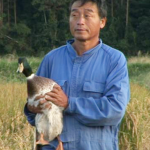 Dr Furuno’s sustainable biosystem eliminates the need for fertilizers, herbicides and pesticides by incorporating duck-raising, fish and azolla into organic rice cultivation.
Dr Furuno’s sustainable biosystem eliminates the need for fertilizers, herbicides and pesticides by incorporating duck-raising, fish and azolla into organic rice cultivation.
The approach is now being replicated with substantial success all over south-east Asia as an effective way to boost farmers’ incomes, reduce environmental impact and improve food security.
Takao’s passion for the preservation and health of the small family farm is backed up by a deep understanding of how modern society works. “My dream,” says Takao, “is to see ducks cheerfully swimming around in all the rice paddies of Japan and other Asian countries”.
KUWAIT
Dr. Sudhersan Chellan, Department of Environment and Life Science Research Centre, the Kuwait Institute for Scientific Research (KISR)
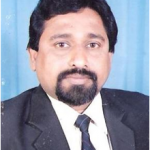 Dr. Chellan did his M.Sc. and M.Phil. at Madras Christian College and his Ph.D. at Madurai Kamaraj University.
Dr. Chellan did his M.Sc. and M.Phil. at Madras Christian College and his Ph.D. at Madurai Kamaraj University.
He has worked as a plant tissue culturist for the past 25 years. Since 1996 Sudhersan has worked as a research Scientist at the Biotechnology Department of Environment and Life Science Research Centre at the Kuwait Institute for Scientific Research (KISR), studying Date palm, Moringa, azolla and medicinal plants.
Sudhersan has the following interests in azolla:
- To introduce azolla in Kuwait
- To develop a simple culture media to grow azolla
- To acclimatize azolla to Kuwait’s harsh climatic condition
- To utilize azolla as feed for fish, cattle and poultry
- utilize it in organic agriculture as biofertilizer
Dr. Sudhersan Chellan can be contacted at schellan@kisr.edu.kw
MALAYSIA
Mahathir Abu Khalipa, independent farmer
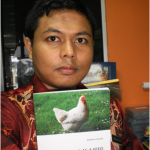 Mahathir is an enthusiastic promoter of azolla’s use as a livestock feed and biofertilize. He has written to us to say:
Mahathir is an enthusiastic promoter of azolla’s use as a livestock feed and biofertilize. He has written to us to say:
“I wish more and more people in the world, especially farmers, were aware of the advantages of using azolla in their farms as a bio-fertilizer and to feed their poultry.”
The photograph shows Mahathir proudly holding the book: “Azolla as a feed ingredient”, which is featured on this page. Please contact him by email for more information about his interests and work with azolla: mahathir_abukhalipah@yahoo.co
Ahmad Muaz Abdul Mutalib, independent poultry farmer and azolla enthusiast, Penang
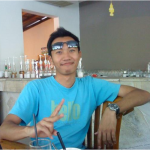 Ahmad’s three acre poultry farm is located in Penang, a northern state in Malaysia, approximately four hour’s drive from Kuala Lumpur. The farm grows broiler chickens and uses only natural sustainable methods, including effective microbes as a supplement to the poutlry feed, without the use of any antibiotics.
Ahmad’s three acre poultry farm is located in Penang, a northern state in Malaysia, approximately four hour’s drive from Kuala Lumpur. The farm grows broiler chickens and uses only natural sustainable methods, including effective microbes as a supplement to the poutlry feed, without the use of any antibiotics.
Ahmed is initiating projects with the Universiti Kebangsaan Malaysia (UKM) to undertake detailed research into azolla’s use as a source of protein for local broilers chickens.
MEXICO
Fresia Ramirez, United Nations Program
 Fresia Ramirez has worked on the United Nations Programs and she has also spent many years helping smallholders and indigenous people in Southern Mexico.
Fresia Ramirez has worked on the United Nations Programs and she has also spent many years helping smallholders and indigenous people in Southern Mexico.
Her goal is to stimulate the growth of a managerial culture based in the innovative processes and training.
Fresia is presently working to fund azolla’s use in Ecuador, as part of the project led by Dr. Mariano Montaño Armijos. Although the fund is a private institution, its structure and methodology has become an important humanitarian model for funding pre-investment steps of agribusiness for small and medium-sized businesses organized as co-operative structures.
Other funded projects include those undertaken by universities, research centers and government organizations.
NEW ZEALAND
Donn and Mary Groom, independent farmers and azolla enthusiasts
Donn Groom and his wife Mary own a 50 acre farm in New Zealand’s North island, near to the beautiful Bay of Islands. Donn has built a large mud, brick and stone house using local materials, which incorporates a micro hydro power system using water from the adjacent river, shown on his website. The river is highly polluted from intensive upstream dairy and beef farming, resulting in the extensive growth of azolla.
The pond became so choked that Donn and Mary decided to initiate an annual azolla harvesting program and in 2013: “they removed about 30 car trailer loads of azolla, sharing some with friends and the remainder going on to our own garden….. the results were truly amazing, with fruit and vegetables that are vastly different from the tasteless supermarket varieties….. and the water running out of the pond and through the hydro system was almost drinkable!”
Donn and Mary’s objective is to apply Keyline principals to develop and expand their system of water storage using azolla and other plants such as vetiver grass, with purpose-built ponds and channels to filter and clean the water and produce local, renewable food and power.
“Reading information onazolla and vetiver grass gives me great hope that an integrated system really works. This type of system is badly needed in New Zealand where, contrary to the highly promoted image of a clean green 100% pure image, some of the most polluted rivers in the world are found….our river being one of them.”
PORTUGAL
Francisco Carrapiço, Assistant Professor of the Department of Plant Biology in the Faculdade de Ciências da Universidade de Lisboa, Centre for Environmental Biology (http://cba.fc.ul.pt/)
 Dr Carrapiço is one of the world’s leading experts on azolla and a vigorous promoter of azolla’s multiple benefical uses. His main research interests are the azolla–anabaena-bacteria symbiotic system, symbiomics, and the origin of life and cell evolution.
Dr Carrapiço is one of the world’s leading experts on azolla and a vigorous promoter of azolla’s multiple benefical uses. His main research interests are the azolla–anabaena-bacteria symbiotic system, symbiomics, and the origin of life and cell evolution.
Francisco is the author of numerous publications on azolla, including the landmark paper ‘Azolla as a Superorganism. Its implications in symbiotic studies.
He has kindly arranged that a pdf of this publication (AzollaSuperorg_2010.pdf) and more than 30 of his other papers, can be can be downloaded for free from http://azolla.fc.ul.pt/publicacoes.html.
Dr. Ana Luisa Pereira, Interdisciplinary Centre of Marine and Environmental Research (CIIMAR), Porto, Portugal
 Dr. Ana Luisa Pereira is a plant biologist who has worked with azolla for more than 15 years, beginning as a undergraduate at the University of Lisbon where she studied under Dr Francisco Carrapiço.
Dr. Ana Luisa Pereira is a plant biologist who has worked with azolla for more than 15 years, beginning as a undergraduate at the University of Lisbon where she studied under Dr Francisco Carrapiço.
Dr. Pereira’s research deals with almost all the aspect of this unique symbiotic system, including azolla’s morphology, ultrastructure, phylogeny, bioactive compounds, ecotoxicology, and phytoremediation. She is also interested in determining how agronomic plants cope with the presence of cyanotoxins in water and soil and the potential of symbiotic cyanbacteria to produce bioactive compounds.
Dr. Pereira’s key interests are 1) bioactivity of azolla extracts against bacteria, fungi and tumour cells; 2) identification of the bioactive compounds; and 3) phylogeny of the genus Azolla and Anabaena azollae species.
Dr. Pereira’s research has included testing the phytoremediation and bioaccumulation of cyanotoxins present in water by azolla. Her results show that living azolla plants do not bioaccumulate cyanotoxins, so that the plant is not suitable for phyotoremediation of cyanotoxins (dried biomass have not yet been tested). This indicates that azolla grown in water contaminated with cyanotoxins can be used as a biofertilizer, livestock feed and as food after washing azolla with water. Her results therefore have a major positive significance for azolla’s use as a food, livestock feed and biofertilizer in locations where it grows in water contaminated with cyanotoxins.
Ana Luisa Pereira can be contacted at anapereira271268@yahoo.com, and via her page at www.researchgate.net.
SRI LANKA
Professor S. A. Kulasooriya, Emeritus Professor of Botany
Professor Kulasooriya is an Emeritus Professor of Botany who retired from the University of Peradeniya, Sri Lanka, in 2006 after 40 years of service as an academic staff member.
He obtained his PhD degree from the University of London (1968 – 71), working on nitrogen fixation in cyanobacteria, and spent his 1978/79 sabbatical year at the International Rice Research Institute (IRRI).
He is currently working at the National Institute of Fundamental Studies, Kandy, Sri Lanka, as a Visiting Research Professor.
Professor Kulasooriya worked on cyanobacteria and azolla, publishing six research papers and co-authoring a book with Dr. P. A. Roger titled “Blue-Green Algae & Rice (1980)” published by the IRRI. During a short-term consultancy at the International Atomic Energy Agency In Vienna (1882/83/84), he initiated a coordinated research project on the application 15N isotope technology to estimate and quantify nitrogen fixation by azolla in rice fields in 10 participating countries across the tropical belt from Brazil to China
In 1987/88, Professor Kulasooriya spent part of his second sabbatical at the Weizmann Institute of Science, Israel, working in collaboration with Professor Shmuel Malkin and Professor Elisa-Tel-Or of the Faculty of Agriculture, University of Jerusalem, and published three research papers on azolla. He has now extended his research studies to nitrogen fixation in crop and pasture legumes in symbiosis with Rhizobium.
SWEDEN
Professor Birgitta Bergman, Department of Ecology, Environment and Plant Sciences, Stockholm University
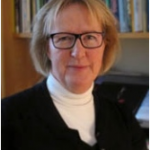 Professor Bergman’s research includes [1] molecular diversity and function of the Baltic Sea microbiome with a focus on cyanobacteria, [2] the evolution, adaptation and cell differentiation in marine cyanobacteria, that live freely and also in symbiosis with eukaryotes including azolla, and [3] the cyanobacterial toxin BMAA and its neurodegenerative effects.
Professor Bergman’s research includes [1] molecular diversity and function of the Baltic Sea microbiome with a focus on cyanobacteria, [2] the evolution, adaptation and cell differentiation in marine cyanobacteria, that live freely and also in symbiosis with eukaryotes including azolla, and [3] the cyanobacterial toxin BMAA and its neurodegenerative effects.
Her analyses are primarily undertaken at the metagenomic, genomic, transcriptomic, proteomic and cellular level.
Birgitta is working with the Azolla Foundation and Azolla Biosystems Ltd to analyze the genetics of different azolla-anabaena species and hybrids.
Professor Bergman is a member of the Royal Swedish Academy of Sciences.
Erik Sjödin, azolla food expert and author of ‘The Azolla Cooking and Cultivation Project’
 Erik is a pioneer in azolla’s use as a food, traveling widely to research ways in which azolla can be grown and cooked.
Erik is a pioneer in azolla’s use as a food, traveling widely to research ways in which azolla can be grown and cooked.
His work highlights azolla’s potential to provide nutrition, of major significance as our population passes seven billion. This complements research into azolla’s use as a food and water purifier in Controlled Ecological Life Support Systems (CELSS) for space and planetary travel and colonization.
THAILAND
Supachai Pitiwut, Azolla enthusiast and founder of the Weekend Farmer Network, Thailand
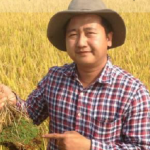 Supachai Pitiwut founded Thailand’s Weekend Farmer Network which has developed an Integrated System of Rice Intensification (SRI), using alternate ‘Wet and Dry Cultivation’ of rice which increases rice yield, saves water and reduces emission of the greenhouse gas methane.
Supachai Pitiwut founded Thailand’s Weekend Farmer Network which has developed an Integrated System of Rice Intensification (SRI), using alternate ‘Wet and Dry Cultivation’ of rice which increases rice yield, saves water and reduces emission of the greenhouse gas methane.
Azolla is an integral component of both the Wet and Dry Phases, and extensive trials across Thailand have demonstrated its economic and environmental benefits, including reduced use of herbicides, moisture retention in the soil by azolla during Dry Cultivation, reduced pests including the brown plant hopper and fungi, water savings of 25% to 40%, the provision of azolla food for ducks, and reduced costs.
The Weekend Farmer Network Facebook page provides extensive information about Wet and Dry Cultivation of rice and includes videos (in Thai) illustrating its use. The method has also been documented in a scientific publication by Doi & Supachai: ‘Wet/dry paddy cycles to optimize rice production for total quality of life: regarding rice as a water-resistant plant’.
You can read more about ‘Wet and Dry Cultivation’ of rice on this page.
Supachai Pitiwut can be contacted at supachai.sup@gmail.com
THE NETHERLANDS
Dr Monique van Kempen, Department of Aquatic Ecology & Environmental Biology, Radboud Universiteit Nijmegen
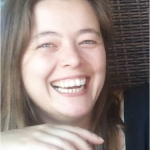 Monique’s work exemplifies ways in which research into modern (extant) azolla has a direct bearing on our understanding of fossil azolla and the massive climatic shifts that resulted from the Arctic Azolla Event 50 million years ago.
Monique’s work exemplifies ways in which research into modern (extant) azolla has a direct bearing on our understanding of fossil azolla and the massive climatic shifts that resulted from the Arctic Azolla Event 50 million years ago.
Her biological experiments on the eco-physiological boundary conditions of extant azolla provide crucial data for interpreting the ecological and biochemical functioning of fossil species that were associated with the Arctic Azolla Event.
Monique is also working on a variety of projects involving extant azolla. These include
-
The use of azolla and duckweed to reduce nitrogen and phosphorus concentrations in effluent leaving water purification plants.
-
The use of azolla as an ecosystem engineering tool to recycle phosphorus loads in soils of former arable lands that are inundated for wetland development and/or for water storage purposes.
-
Azolla farming as a form of paludiculture (rewetting of drained peatlands) aiming to reduce the effects of eutrophication, improve water quality and recycle phosphorus.
Details of Monique’s work and publications are listed on her webpage.
THE PHILIPPINES
International Rice Research Institute (IRRI)
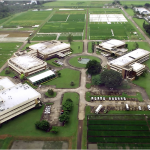 IRRI develops new rice varieties and rice crop management techniques that help rice farmers improve the yield and quality of their rice in an environmentally sustainable way.
IRRI develops new rice varieties and rice crop management techniques that help rice farmers improve the yield and quality of their rice in an environmentally sustainable way.
It works with public and private sector partners in national agricultural research and extension systems in major rice-growing countries to do research, training, and knowledge transfer. Its social and economic research also informs governments to help them formulate policy to improve the equitable supply of rice.
IRRI has the largest germplast collection of azolla in the world with more than 500 hybrids, which it has kindly agreed to make available to the Azolla Foundation for research projects.
Dexter C. Terrado, independent Azolla researcher and distributer, the Philippines
 Dexter’s interests in azolla include its use as a livestock fodder/feed supplement, as a green manure for rice paddies and its use as a bulk part for worm feedstock in vermicomposting.
Dexter’s interests in azolla include its use as a livestock fodder/feed supplement, as a green manure for rice paddies and its use as a bulk part for worm feedstock in vermicomposting.
Dexter has written to us to say that: “I am one of the many (in the Philippines) who promote backyard cultivation of azolla, and its use as livestock feed supplement, green manure, etc. I also distribute azolla culture starters within the Philippines for those who are interested in growing them. This activity is only a part of the greater thrust towards organic food production in the country.”
Dexter has kindly let us know that he will provide azolla starters for free and that they can be collected from his location or they can be sent within the Philippines by courier providing interested parties pay the handling/shipping cost.
His contact details are: email address greyhound309@gmail.com and mobile +63-910-870-9731.
UGANDA
Hannington Kamuhanda Mwine, Director of AGRI-Inputs programmes in Uganda
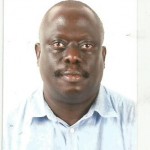 Hannington Kamuhanda Mwine has a BA Honours degree in Economics & Rural Economy from Makerere University Kampala). Currently he is the Director of Farmland Consults Uganda Ltd – Agriculture Science Pack Project undertaking seed production of different pasture varieties, animal breeding (pigs, poultry, dairy, fish fingerlings etc) and vocation agriculture training programmes for youth and women empowerment.
Hannington Kamuhanda Mwine has a BA Honours degree in Economics & Rural Economy from Makerere University Kampala). Currently he is the Director of Farmland Consults Uganda Ltd – Agriculture Science Pack Project undertaking seed production of different pasture varieties, animal breeding (pigs, poultry, dairy, fish fingerlings etc) and vocation agriculture training programmes for youth and women empowerment.
Mr. Kamuhanda is also a director in SARO AGENCIES LTD, a Commodity & Seed Enterprise based in Wakiso District, Uganda.
He has done training in rural poverty reduction and sustainable agriculture growth organized by the World Bank Institute and Uganda management institute (UMI) in Kampala.
He has also done Maize Breeding & Seed Production courses organized by CIMMYT. Other courses he has undertaken include building competitive input markets to benefit small holder farmers organized by the International Fertilizer Development Centre (IFDC).
Mr Kamuhanda has worked in Produce Marketing companies, Seed Projects, and East Africa Seed Uganda7 where he gained considerable experience in grain and seed handling, storage, marketing and technology dissemination in Uganda.
Mr. Kamuhanda has initiated a pilot project under the Science Pack Project in Uganda in which 3 acres of land have been converted into a series of shallow water enclosures with azolla for azolla seed multiplication and the cultivation of azolla–based feeds to be used in our demo farms programmes.
Mr. Kamuhanda has written to say: “We do believe azolla can come to our rescue in this direction as we try to train our young farmers in sustainable agriculture to reduce poverty, especially among unemployed youth. Having experimented with duckweed Lemnaceae without much success we believe azolla is the correct green growth technology; and we are prepared to make strong partnerships with other key players in research and commercialization of azolla world-Wide.”
Mr Kamuhanda can be contacted at: hankamuhanda@gmail.com
UNITED KINGDOM
University of Plymouth
Dr (Philip) Chris Reid, Professor of Oceanography, Marine Institute, University of Plymouth
 Chris is an expert on ocean science and climate change and is working with the Dr Jonathan Bujak and the Azolla Foundation to integrate oceanographic data with climate change triggered by the Arctic Azolla Event and anthropogenic changes in today’s climate.
Chris is an expert on ocean science and climate change and is working with the Dr Jonathan Bujak and the Azolla Foundation to integrate oceanographic data with climate change triggered by the Arctic Azolla Event and anthropogenic changes in today’s climate.
He is also a Senior Research Fellow of the Sir Alister Hardy Foundation for Ocean Science (SAGFOS) and Honorary Fellow, Marine Biological Association of the UK.
UNITED STATES
Dr Ian Miller, Department Chair of Earth Sciences and Curator of Paleontology, Denver Museum of Nature and Science
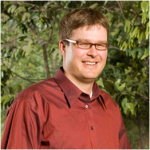 Dr Ian Miller is chair of the Earth Sciences Department and curator of paleontology at the Denver Museum of Nature & Science.
Dr Ian Miller is chair of the Earth Sciences Department and curator of paleontology at the Denver Museum of Nature & Science.
His research focuses on fossil plants and their applications for understanding ancient elevation, climate, and the position of continents.
He is currently working on projects in the Colorado Rockies, the Grand Staircase Escalante National Monument in Utah, and in Madagascar.
Ian is the leader of the Snowmastodon Project®, the Museum’s largest-ever fossil excavation project at Ziegler Reservoir near Snowmass Village, Colorado. During the seven-week dig, 6,000 bones representing more than 40 different animals were uncovered.
Ian kindly provided the image of fossil azolla from Colorado and he can be contacted by email at ian.miller@dmns.org

